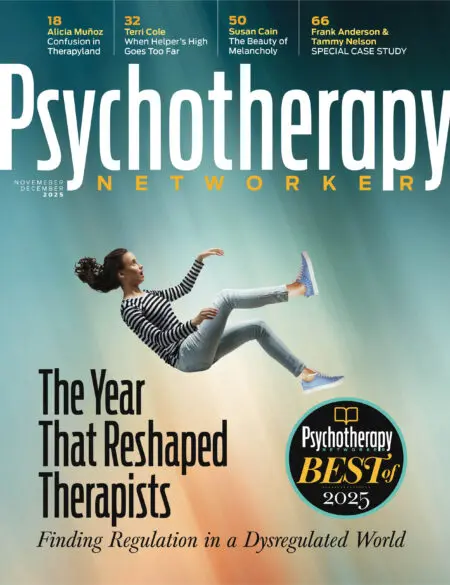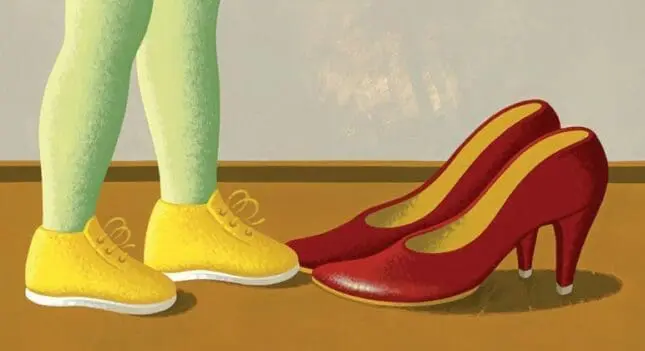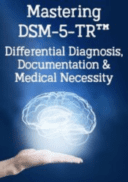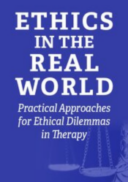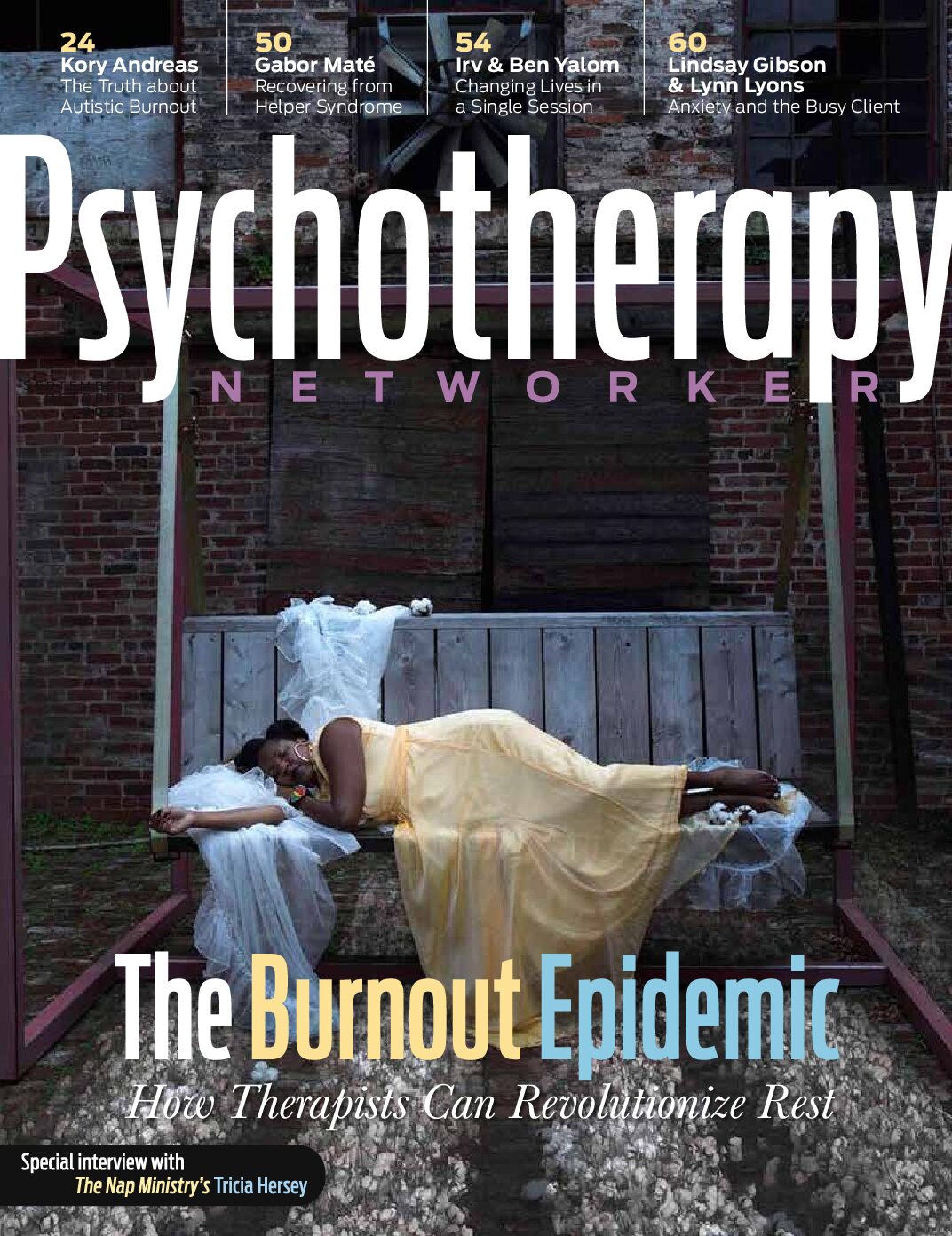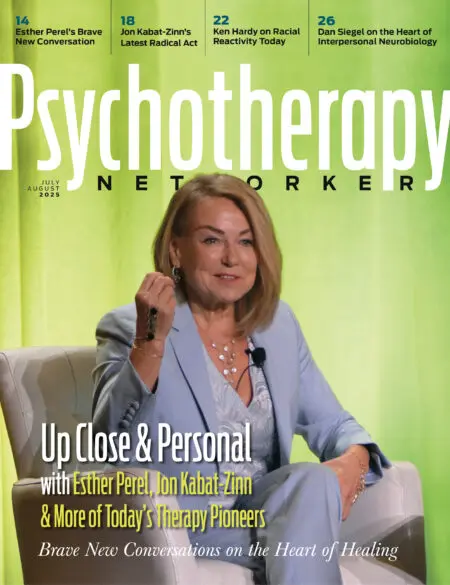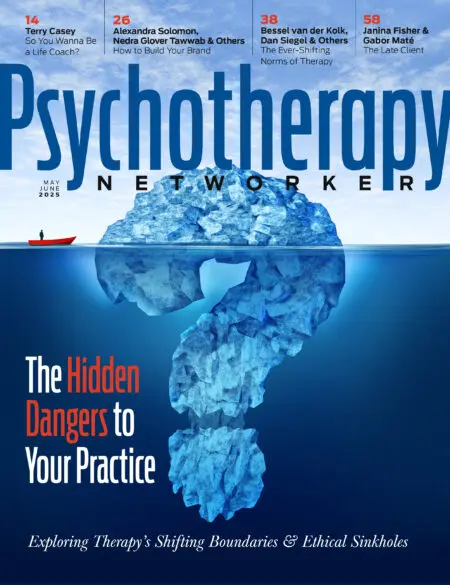Mom gleefully holds up two crossword books and says, “See, 111 puzzles in each. They’ll keep me here a long time. When I finish them, I can die.”
Mom, age 99, hasn’t talked about dying in a while. I remember with a shudder her plaintive calls last year in the hospital after her 10th fall, her head gashed and bleeding. “I want to die. Please . . . die,” she’d said. The words still careen back and forth in my mind. Now, I grab the opening Mom has presented and ask, “What are you feeling about dying?”
She replies with bravado, “I couldn’t care less if I die.” A slow swallow. “I can’t do anything about it.”
I stroke her back, something that she loves. “Are you afraid or scared?”
“I’m in great shape.” She says nothing about her emotions, and I feel a sear down the center of my breastbone—the old flagrant hope of getting a glimpse into Mom’s feelings, hope that first infiltrated my body when I was eight years old. Tottering in Mom’s high heels, I’d reached into her jewelry drawer for the silver wedding chain I loved to wear for dress-up. But what was this folded piece of paper under the box that held the chain? I opened it and read in Mom’s pointy handwriting: “I want to die here in the meadow. The lupine and Indian paintbrush around me.”
My young mind raced. Die? Kicking the heels aside, tripping over the long, beaded skirt, I ran with the note to my 12-year-old sister. She wanted nothing to do with it. After that, every week until I was 16 and we sold our house and moved to Kuwait, I snuck into Mom’s jewelry drawer, searching for clues to her inner world in her words written on the backs of drugstore receipts and paper torn from grocery bags.
I read her grief about Dad and “that other red-haired woman.” I read her anger toward her parents: “I did not love them after they hit me with my father’s razor strop.” I kept her secrets and never told that I was reading the notes. And yet she seemed to know. She always encouraged me to play with her earrings and necklaces.
Now, at Mom’s apartment, I try to rally. “For someone who’s almost 100, you are in good shape!”
Mom lifts up her arm and tries to flex her biceps. Then for the third time in 10 minutes, she asks, “Who gave me these crossword books?”
“The visiting nurse,” I say. I backtrack to what I’ve been trying to accomplish for the last half hour. “Let’s go into the bathroom and cut your fingernails.”
Mom says mischievously, “I thought you were going to suggest something I might need for dying.”
“Like what? What is it you might need?” I think of the phone numbers I’ve saved of the bedside harpist, and the singers who offer, according to the brochure, “songs of hope and comfort for the dying.”
“Need for dying? That’s up to you,” Mom says as she carefully positions herself on the edge of her bed, grasps her walker with one hand, and pushes her fist hard against the mattress. I watch with wonder as she launches herself upright. She shuffles to the bathroom, saying nonsensically, “You’re going to cut off my toes.”
“Nope,” I laugh. “They’re going to stay on you. You need them. I’m going to cut your nails.”
“I think I’m getting old enough to cut my own,” she retorts with a glint in her green and blue-flecked eyes.
This playful humor emerged in Mom a few years ago, when following threads of conversation became increasingly difficult for her. She connects now with banter and wordplay. Physical therapists, care assistants, and doctors all started calling her “adorable”—a new way for me to think about her. I try to catch her humor, play along, and appreciate these emerging aspects of her, so different from the anxious and depressed mother I grew up with.
Then something else happened that expanded our relationship even more: my daughter and her partner, somewhat unexpectedly, announced they were having a baby. Soon we knew it was a girl—my first and most likely only grandchild, and Mom’s only great-grandchild. My three siblings had all chosen not to have children.
“Mom, you’re going to be a great-grandmother! Great-Grandma Ga!” I’d sing out each time I visited her. We kvelled over the photos of her pregnant granddaughter and ultrasound images of her great-granddaughter in utero.
Before my daughter became pregnant, my caretaking patience with Mom had been tattered. Fifteen years was longer than I’d bargained for when I moved her from the West Coast to live near me. Wishing for her death—especially at times when she struggled through life-threatening bouts with pneumonia, yet another fall and extensive time in rehab, which meant a multitude of new services to organize, more bills—jammed my brain more often than I wanted to admit.
But after my granddaughter’s birth, Mom and I would hunch eagerly over photos of Cadence riding home from the hospital in her infant car seat. We’d giggle together watching videos of Cady laughing as she pulled her father’s hair, then dancing up and down in her hot-pink onesie to songs on the radio. Four generations of females alive at the same time—a first on my mother’s side of the family! I wanted Mom to live longer so she could revel in her next visit with her great-granddaughter. I wanted Cady to grow up having vivid memories of Mom.
I found myself spending hours upon hours with my granddaughter curled into my left shoulder, feeling Cady’s beating heart against mine, her rhythms imprinting into my body. As I walked with her, I thought of Mom. Old, hard memories began to shift and move. Cady taught me anew how relationally wired we are, how we want to connect and be seen—something Mom needed from me.
When Cadence was one, I walked into Mom’s assisted living apartment with a list of more than 100 words she now knew. I read, “Goat, gazpacho, bikle [bicycle], neigh-neigh.” Mom shook her head in amazement.
“It’s in the genes, Mom,” I said. “I remember you teaching me what the letters spelled on the side of the green van: King County Bookmobile. You loved words and books, and wanted me to love them too.” Mom nodded appreciatively. For a moment, I found myself back inside the bookmobile, breathing in reassuring smells of ink and paper. Then whiffs returned of cloyingly sweet air freshener with an underlay of urine. I asked Mom, “How did you talk the county into parking that bookmobile in our driveway each month, anyway?”
She chuckled and said quietly, “I don’t remember.”
With Cady learning new words every day and Mom forgetting them, my convoluted relationship with words and my family is resurrected. Yes, we had books and stories growing up, but no language given by my parents to understand Dad’s suicidal depression, electroshock treatments, and disappearances from the family into a “special hospital,” which I later learned was the state mental institution. It was a childhood saturated with fragments and scraps of information that I strained to fit together.
In our home office, there were always scribs and scrabs of paper with Mom’s jottings. Unlike the secret ones hidden in her drawer, they were piled precariously on the side of the desk, out and available to all. On them, she wrote things my siblings and I said that she intended to turn into children’s books, like “Janine asked Brian [my older brother] ‘What kind of woman will you marry?’ Then she said, ‘Oh, I suppose you’d like somebody who’d play out in the woods with you all the time.’” I liked reading these story snippets. They told me Mom was paying attention to us.

Recently, when I’d moved Mom into yet another level of care, I opened her safe, expecting to find her will and bank information. Instead, there were those long-ago stacks of story fragments—ideas that never did get turned into books. I lifted a pile of them up out of the safe, and a small orange book, stuffed into the middle of them, fell out. On the inside cover Mom had written, “Please select a few of these memories to read at my memorial service.” Although the book had only seven entries scattered in its 100 pages, a few story snippets had been slipped into the back of it, as if Mom intended to do something in particular with them.
Now, I take Mom’s orange book home and leaf through it. Once again, I’m reading her notes, albeit ones she’s asked to be shared. I think about which memories I might actually use for her service, maybe the time she wrote she was “a princess! (not the queen) in the Bonneville Chamber of Commerce 4th of July parade.” But mostly the pages are blank. I pull out the story fragments still tucked into the back of the book and spread them out: Mom’s remembrances of us children never elaborated upon, and yet she carried them with her through seven decades and moves to Kuwait, Argentina, and Mexico.
My mind wanders to the notes I’ve written about Cady on my own bits of paper. Suddenly, I know what I have do. I turn the orange book upside down and inscribe in the front, “Dearest Granddaughter, This memory book is for you.” I write in it how my daughter thought she became pregnant on my birthday, how she, dear Grandbaby, didn’t want to leave Hotel Womb, and our strategies to invite her out. I find myself intertwining stories about her parents’ and grandparents’ lives.
Slowly I become aware of how I’m amplifying some stories while ignoring and letting go of others. Perhaps, I realize, we can choose what stories to tell, when and where, and thus shape and change our lives. Then onto the center pages, I trim, fit, and glue the story ideas Mom had slipped into the orange book eons ago. I can imagine Cadence one day opening the orange book and reading it to her own child.
Janine Roberts
Janine Roberts, Ed.D., professor emerita at the University of Massachusetts, Amherst, is the author of Tales and Transformations and Rituals for Our Times.
